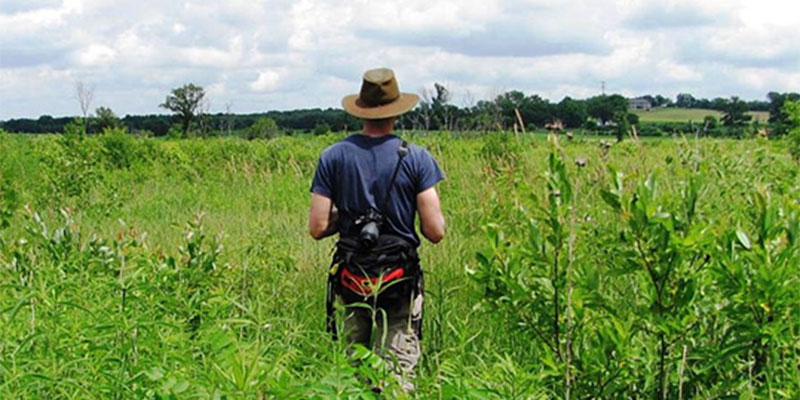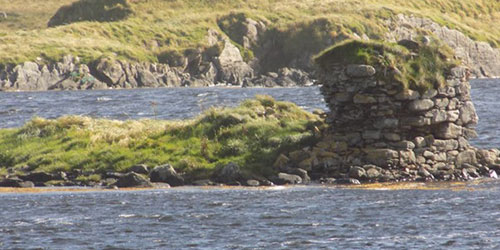Exhaustion, Extinction, and Recovery
Postdoctoral Researcher Brennen Fagan reflects on loss in research, and how some researchers move forward.

As a mathematician, the beings I watch disappear in my research are simulated at best and temporary data at worst. I am not directly connected to the butterflies and other things that are extirpating or emigrating, even as I try to think about the processes that drive these changes in the world around us. The biologists and conservationists around me are not so removed. They occupy an odd middle ground between theory and practice, almost as if they were historians forced to travel back to the end and the fall of their periods of study or archaeologists forced to watch their archaeological site torn down by erosion. There is a lot to be said about being in that position – for instance, the recent LCAB article proposing a conservation framework (Thomas et al., 2022) – but I want to reflect on the human aspect and how this feeds back into the research process.
FiveThirtyEight’s Maggie Koerth recently authored a related article (Koerth, 2022). In it, Koerth chronicles the efforts by scientists to save the last of the Poweshiek skipperling butterflies. Their range has declined dramatically since 1985, and the conservationists who search for them, to take them into captivity to ensure the creation of the next generation, are forced to watch the butterflies die both as a species and as short-lived individuals. The decline seemed to start as perhaps easily dismissed rumours, but today seems irrefutable, with the species seemingly around only because conservationists have created a new artificial life cycle for the Poweshieks. But of course, the Poweshiek is not alone.
How do these scientists keep going when confronted with what appears to be impending doom? Indeed, what should we do with our growing eco-anxiety? Perhaps unsurprisingly, people study this too (Hayes et al., 2018; Panu, 2020). The recommendations seem to be equal parts community and individual action. We are generally aware of the policy level initiatives, e.g., the various COPs on climate change, conservation, and biological diversity, but it is often harder to see how we can engage ourselves. This engagement, of individuals actively working with and in a community, seems to be the critical point. On the one hand, it looks like Macy’s and Johnstone’s “active hope”, where individuals actively participate in mitigating problems in pursuit of something better. Indeed, the actions to deal with eco-anxiety often result in both learning how to better the environment as well as managing our anxieties. For example, conservationists now know a lot more about how to rear not only Poweshieks, but butterflies more generally (Koerth, 2022).
On the other hand, there is something more than triage at work. We can revisit that initial analogy: many archaeologists are watching the object of their lives’ works get torn down by natural processes, and there is not enough money and time to save everything. The key for some might be “adaptive release” (DeSilvey et al., 2021). The principle is not to prevent the loss of everything. Indeed, archaeology as a discipline understands that new knowledge often comes with loss – you can’t excavate an archaeological site twice. Archaeologists already accept that some, if not all, sites will degrade and that contexts change over time. The shift is instead away from preserving as much as we can while extracting knowledge and towards monitoring, interpretation, and learning from the process of decline itself alongside the local community. Adaptive release is therefore not neglect but a gradual and transparent shift in conservation priorities punctuated by revisiting and re-studying sites.

Photo courtesy of Michael Stratigos, Castle Holm, Loch of Strom, Shetland. “Castle Holm is a probable 12th-16th century castle on an artificial island rapidly disappearing as sea-level rises. Substantial loss of upstanding portions of this Scheduled Ancient Monument has been documented since the 1980s.” See also Canmore.
Even if we could, we do not seek to put the natural world in a bottle. That is not the point. Instead, the act of conservation has emergent value in and of itself, and each individual’s benefit is more than multiplied when a community rallies to support the act. Even if the act of conservation fails and all we are left with are the things that we could place in glass bottles, to not have tried seems more hopeless than to have tried and failed. We also do not know if our efforts will fail and we can learn from those that do. There is even the possibility that we might succeed.
What about for the mathematician, who constructs many simple worlds in many bottles to better understand how the natural world works? I think this emphasises the interdisciplinary nature of our work. If we feel the call-to-arms in our work – if we work in a field that has a moral imperative and we accept this imperative – we need to do more than design models for spherical cows in vacuums. No model will be right, but by designing models that get to the heart of our colleagues’ questions, we can make them useful. Even old models – and old questions – can deserve revisiting, whether to better understand your colleagues’ thoughts, to repurpose for new questions, or to improve your own models. And, of course, it is worth remembering why we model in the first place: amongst other things, to communicate clearly and better our understanding (Epstein, 2008). No-one is planning on solving conservation by themself and actively working as a community seems to be where optimism and hope lie.
Bibliography
DeSilvey, C. et al. (2021) ‘When Loss is More: From Managed Decline to Adaptive Release’, The Historic Environment: Policy & Practice, 12(3-4), pp. 418–433. Available at: https://doi.org/10.1080/17567505.2021.1957263.
Epstein, J.M. (2008) ‘Why model?’, Journal of artificial societies and social simulation, 11(4), p. 12. Available at: http://jasss.soc.surrey.ac.uk/11/4/12.html.
Hayes, K. et al. (2018) ‘Climate change and mental health: risks, impacts and priority actions’, International journal of mental health systems, 12, p. 28. Available at: https://doi.org/10.1186/s13033-018-0210-6.
Koerth, M. (2022) The butterfly effect, FiveThirtyEight. Available at: https://fivethirtyeight.com/features/the-butterfly-effect-2/ (Accessed: 31 January 2023).
Panu, P. (2020) ‘Anxiety and the Ecological Crisis: An Analysis of Eco-Anxiety and Climate Anxiety’, Sustainability: Science Practice and Policy, 12(19), p. 7836. Available at: https://doi.org/10.3390/su12197836.
Thomas, C.D. et al. (2022) ‘FAR‐sighted conservation’, Ecological Solutions and Evidence. Available at: https://doi.org/10.1002/2688-8319.12188.